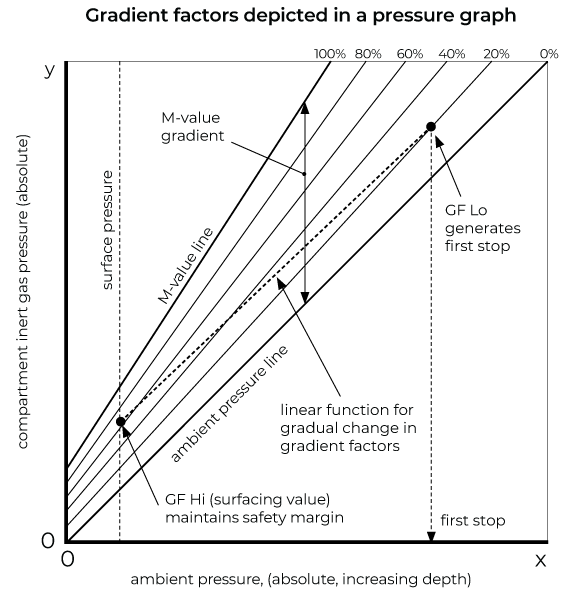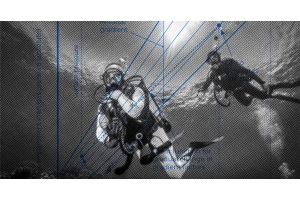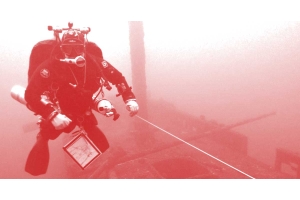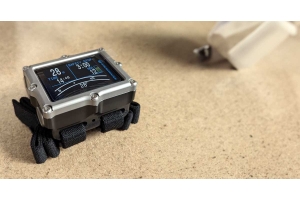An explanation of Bühlmann gradient factors

An explanation of Bühlmann gradient factors
Swiss physician Albert Bühlmann developed algorithms to help divers avoid decompression sickness (DCS). Although he was not a diver, he was fascinated by a local diver, Hannes Keller, who had an intricate understanding of mathematics.
Keller had developed tables for mixed-gas compression. His ideas were refined by Bühlmann, who suggested appropriate breathing gasses for Keller’s experiments.
After several years studying and experimenting, Bühlmann produced a number of algorithms, the most famous of which is the ZH-L16 model. This is still widely used today by divers around the world.
Bühlmann’s decompression tables are a cornerstone of recreational and technical diving. They are comprised of gradient factors to adjust the rate of ascent and decompression stops, which are crucial for preventing DCS.
What are Bühlmann gradient factors?
Bühlmann gradient factors are mathematical values that represent the rate at which nitrogen and other inert gases are absorbed and eliminated from your body during diving. They are based on the idea that the body behaves as a collection of tissues with different absorption and elimination rates.
These factors are essential for safe diving because they help prevent DCS. By adjusting the decompression stops, gradient factors ensure nitrogen is safely eliminated from your body, reducing the risk of bubbles forming and causing decompression sickness.
How do gradient factors work?
The Bühlmann decompression model uses a series of tissue compartments to represent different body tissues. Each compartment has a specific half-time, determining how quickly it absorbs and releases nitrogen. Gradient factors are applied to these half-times to adjust the decompression schedule.
Albert Bühlmann worked for decades to develop his decompression algorithms, based on dissolved gas theory. Shortly after his passing, 'bubble' models, such as Varying Permeability Model (VPM) and the reduced gradient bubble model (RGBM) emerged. These were aimed at enabling deeper stops during decompression dives, compared to the traditional dissolved gas models. Bubble models gained widespread popularity, prompting decompression divers to execute their initial stops at significantly greater depths than prescribed by other models.
What are M-values?
M-value standards for Maximum Value. It’s a term invented in the 1960s by US Navy researcher Robert D Workman when he was studying decompression theories.
For any given ambient pressure, an M-value is considered as the maximum value of inert gas pressure (absolute) that a hypothetical ‘tissue’ compartment can ‘tolerate’ without presenting strong DCS symptoms.
M-values are representative limits for the tolerated gradient between inert gas pressure and ambient pressure in each compartment.
Why M-values are important
Erik Baker devised diving gradient factors as a means to modify the Bühlmann algorithm, enabling deeper stops. A prevalent practice involved employing gradient factors like 30/85, implying that divers would perform their first decompression stop at 30% of the depth Bühlmann recommended and surface at 85% of his calculated safe M-value.
M-values play a crucial role in divers' gradient factors by setting the maximum allowable pressure difference between the inert gas in the diver's tissues and the ambient pressure. This difference is known as the supersaturation gradient.
These values represent the maximum pressure a tissue can tolerate before bubbles form. They are based on various factors, including tissue type, size, and blood flow.
Gradient factors are typically expressed as a percentage of the M-value. A higher gradient factor means the diver stays closer to their M-value during ascent, which can increase the risk of DCS. Conversely, a lower gradient factor means the diver stays further away from their M-value, reducing the risk of DCS.

This graph is one of many from Erik C Baker’s ‘Clearing Up The Confusion About Deep Stops’ paper.
What to consider for your ideal diving gradient factor
These are the important conditions that should be taken into account when picking your gradient factor.
- Dive depth: Deeper dives require more conservative gradient factors to account for the increased nitrogen absorption.
- Dive duration: Longer dives also necessitate more conservative gradient factors to allow for adequate nitrogen elimination.
- Surface interval: The time between dives can affect the gradient factors used for the subsequent dive.
- Physical condition: Your overall health and fitness can influence your body's ability to tolerate nitrogen, affecting the appropriate gradient factors.
A smart way of mitigating decompression risk
Bühlmann gradient factors are an integral part of decompression planning. By understanding how they work and the factors that influence them, you can make informed decisions about your dive profiles and minimise the risk of decompression sickness. You’ll typically find the default settings on your dive computer tend to be aligned with safer diving. Using these conservative values is likely to be a sensible option if you’ve struggled to understand some of the complexities detailed in this blog. Consult a qualified diving instructor for specific guidance based on your dive conditions.







